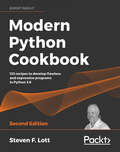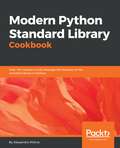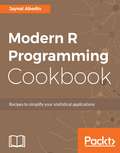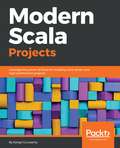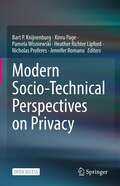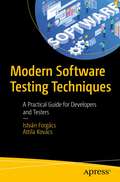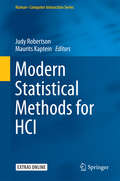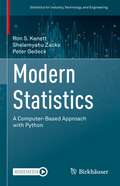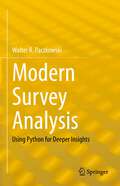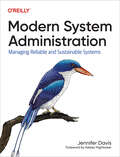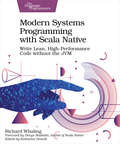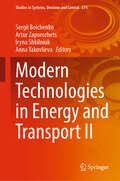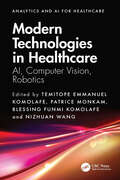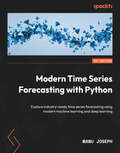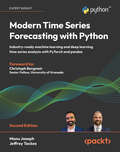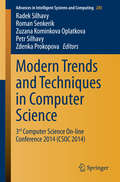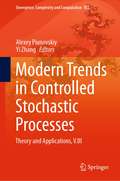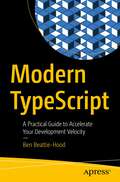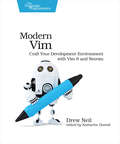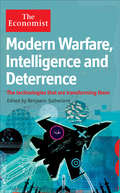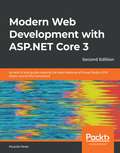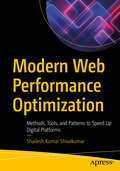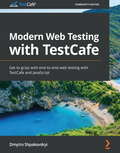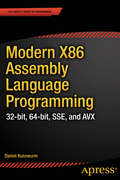- Table View
- List View
Modern Python Cookbook: 133 recipes to develop flawless and expressive programs in Python 3.8, 2nd Edition
by Steven F. LottComplete recipes spread across 15 chapters to help you overcome commonly faced issues by Python for everybody across the globe. Each recipe takes a problem-solution approach to resolve for effective Python. Key Features Develop expressive and effective Python programs Best practices and common idioms through carefully explained recipes Discover new ways to apply Python for data-focused development Make use of Python's optional type annotations Book Description Python is the preferred choice of developers, engineers, data scientists, and hobbyists everywhere. It is a great language that can power your applications and provide great speed, safety, and scalability. It can be used for simple scripting or sophisticated web applications. By exposing Python as a series of simple recipes, this book gives you insight into specific language features in a particular context. Having a tangible context helps make the language or a given standard library feature easier to understand. This book comes with 133 recipes on the latest version of Python 3.8. The recipes will benefit everyone, from beginners just starting out with Python to experts. You'll not only learn Python programming concepts but also how to build complex applications. The recipes will touch upon all necessary Python concepts related to data structures, object oriented programming, functional programming, and statistical programming. You will get acquainted with the nuances of Python syntax and how to effectively take advantage of it. By the end of this Python book, you will be equipped with knowledge of testing, web services, configuration, and application integration tips and tricks. You will be armed with the knowledge of how to create applications with flexible logging, powerful configuration, command-line options, automated unit tests, and good documentation. What you will learn See the intricate details of the Python syntax and how to use it to your advantage Improve your coding with Python readability through functions Manipulate data effectively using built-in data structures Get acquainted with advanced programming techniques in Python Equip yourself with functional and statistical programming features Write proper tests to be sure a program works as advertised Integrate application software using Python Who this book is for The Python book is for web developers, programmers, enterprise programmers, engineers, and big data scientists. If you are a beginner, this book will get you started. If you are experienced, it will expand your knowledge base. A basic knowledge of programming would help.
Modern Python Standard Library Cookbook: Over 100 recipes to fully leverage the features of the standard library in Python
by Alessandro MolinaBuild optimized applications in Python by smartly implementing the standard libraryKey FeaturesStrategic recipes for effective application development in PythonTechniques to create GUIs and implement security through cryptographyBest practices for developing readily scalable, production-ready applicationsBook DescriptionThe Python 3 Standard Library is a vast array of modules that you can use for developing various kinds of applications. It contains an exhaustive list of libraries, and this book will help you choose the best one to address specific programming problems in Python.The Modern Python Standard Library Cookbook begins with recipes on containers and data structures and guides you in performing effective text management in Python. You will find Python recipes for command-line operations, networking, filesystems and directories, and concurrent execution. You will learn about Python security essentials in Python and get to grips with various development tools for debugging, benchmarking, inspection, error reporting, and tracing. The book includes recipes to help you create graphical user interfaces for your application. You will learn to work with multimedia components and perform mathematical operations on date and time. The recipes will also show you how to deploy different searching and sorting algorithms on your data.By the end of the book, you will have acquired the skills needed to write clean code in Python and develop applications that meet your needs.What you will learnStore multiple values per key in associative containersCreate interactive character-based user interfacesWork with native time and display data for your time zoneRead/write SGML family languages, both as a SAX and DOM parser to meet file sizes and other requirementsGroup equivalent items using itertools and sorted features togetherUse partials to create unary functions out of multi-argument functionsImplement hashing algorithms to store passwords in a safe wayWho this book is forIf you are a developer who wants to write highly responsive, manageable, scalable, and resilient code in Python, this book is for you. Prior programming knowledge in Python will help you make the most out of the book.
Modern R Programming Cookbook
by Jaynal AbedinRecipes for emerging developers in R programming and data scientists to simplify their R programming capabilities About This Book • Develop strategies to speed up your R code • Tackle programming problems and explore both functional and object-oriented programming techniques • Learn how to address the core problems of programming in R with the most popular R packages for common tasks Who This Book Is For This book is for developers who would like to enhance the R programming skills. Basic knowledge of R programming is assumed. What You Will Learn • Install R and its various IDE for a given platform along with installing libraries from different repositories and version control • Learn about basic data structures in R and how to work with them • Write customized R functions and handle recursions, exceptions in R environments • Create the data processing task as a step by step computer program and execute using dplyr • Extract and process unstructured text data • Interact with database management system to develop statistical applications • Formulate and implement parallel processing in R In Detail R is a powerful tool for statistics, graphics, and statistical programming. It is used by tens of thousands of people daily to perform serious statistical analyses. It is a free, open source system whose implementation is the collective accomplishment of many intelligent, hard-working people. There are more than 2,000 available add-ons, and R is a serious rival to all commercial statistical packages. The objective of this book is to show how to work with different programming aspects of R. The emerging R developers and data science could have very good programming knowledge but might have limited understanding about R syntax and semantics. Our book will be a platform develop practical solution out of real world problem in scalable fashion and with very good understanding. You will work with various versions of R libraries that are essential for scalable data science solutions. You will learn to work with Input / Output issues when working with relatively larger dataset. At the end of this book readers will also learn how to work with databases from within R and also what and how meta programming helps in developing applications. Style and approach This book will be a companion for R programmer and emerging developers in R programming areas. This book will contain recipes related to advanced R programming which will enable users to solve complex problems efficiently.
Modern Scala Projects: Leverage the power of Scala for building data-driven and high-performant projects
by Ilango GurusamyDevelop robust, Scala-powered projects with the help of machine learning libraries such as SparkML to harvest meaningful insightKey FeaturesGain hands-on experience in building data science projects with Scala Exploit powerful functionalities of machine learning librariesUse machine learning algorithms and decision tree models for enterprise appsBook DescriptionScala, together with the Spark Framework, forms a rich and powerful data processing ecosystem. Modern Scala Projects is a journey into the depths of this ecosystem. The machine learning (ML) projects presented in this book enable you to create practical, robust data analytics solutions, with an emphasis on automating data workflows with the Spark ML pipeline API. This book showcases or carefully cherry-picks from Scala’s functional libraries and other constructs to help readers roll out their own scalable data processing frameworks. The projects in this book enable data practitioners across all industries gain insights into data that will help organizations have strategic and competitive advantage. Modern Scala Projects focuses on the application of supervisory learning ML techniques that classify data and make predictions. You'll begin with working on a project to predict a class of flower by implementing a simple machine learning model. Next, you'll create a cancer diagnosis classification pipeline, followed by projects delving into stock price prediction, spam filtering, fraud detection, and a recommendation engine. By the end of this book, you will be able to build efficient data science projects that fulfil your software requirements.What you will learnCreate pipelines to extract data or analytics and visualizationsAutomate your process pipeline with jobs that are reproducible Extract intelligent data efficiently from large, disparate datasets Automate the extraction, transformation, and loading of dataDevelop tools that collate, model, and analyze dataMaintain the integrity of data as data flows become more complexDevelop tools that predict outcomes based on “pattern discovery”Build really fast and accurate machine-learning models in ScalaWho this book is forModern Scala Projects is for Scala developers who would like to gain some hands-on experience with some interesting real-world projects. Prior programming experience with Scala is necessary.
Modern Socio-Technical Perspectives on Privacy
by Nicholas Proferes Bart P. Knijnenburg Xinru Page Pamela Wisniewski Heather Richter Lipford Jennifer RomanoThis open access book provides researchers and professionals with a foundational understanding of online privacy as well as insight into the socio-technical privacy issues that are most pertinent to modern information systems, covering several modern topics (e.g., privacy in social media, IoT) and underexplored areas (e.g., privacy accessibility, privacy for vulnerable populations, cross-cultural privacy). The book is structured in four parts, which follow after an introduction to privacy on both a technical and social level: Privacy Theory and Methods covers a range of theoretical lenses through which one can view the concept of privacy. The chapters in this part relate to modern privacy phenomena, thus emphasizing its relevance to our digital, networked lives. Next, Domains covers a number of areas in which privacy concerns and implications are particularly salient, including among others social media, healthcare, smart cities, wearable IT, and trackers. The Audiences section then highlights audiences that have traditionally been ignored when creating privacy-preserving experiences: people from other (non-Western) cultures, people with accessibility needs, adolescents, and people who are underrepresented in terms of their race, class, gender or sexual identity, religion or some combination. Finally, the chapters in Moving Forward outline approaches to privacy that move beyond one-size-fits-all solutions, explore ethical considerations, and describe the regulatory landscape that governs privacy through laws and policies. Perhaps even more so than the other chapters in this book, these chapters are forward-looking by using current personalized, ethical and legal approaches as a starting point for re-conceptualizations of privacy to serve the modern technological landscape. The book’s primary goal is to inform IT students, researchers, and professionals about both the fundamentals of online privacy and the issues that are most pertinent to modern information systems. Lecturers or teachers can assign (parts of) the book for a “professional issues” course. IT professionals may select chapters covering domains and audiences relevant to their field of work, as well as the Moving Forward chapters that cover ethical and legal aspects. Academics who are interested in studying privacy or privacy-related topics will find a broad introduction in both technical and social aspects.
Modern Software Testing Techniques: A Practical Guide for Developers and Testers
by István Forgács Attila KovácsMany books have been written about software testing, but most of them discuss the general framework of testing from a traditional perspective. Unfortunately, traditional test design techniques are often ineffective and unreliable for revealing the various kinds of faults that may occur. This book introduces three new software testing techniques: Two-Phase Model-Based Testing, the Action-State Testing, and the General Predicate Testing, all of which work best when applied with efficient fault revealing capabilities. You’ll start with a short recap of software testing, focusing on why risk analysis is obligatory, how to classify bugs practically, and how fault-based testing can be used for improving test design. You’ll then see how action-state testing merges the benefits of state transition testing and use case testing into a unified approach. Moving on you’ll look at general predicate testing and how it serves as an extension of boundary value analysis, encompassing more complex predicates. Two-phase model-based testing represents an advanced approach where the model does not necessarily need to be machine-readable; human readability suffices. The first phase involves a high-level model from which abstract tests are generated. Upon manual execution of these tests, the test code is generated. Rather than calculating output values, they are merely checked for conformity. The last part of this book contains a chapter on how developers and testers can help each other and work as a collaborative team. What You'll LearnApply efficient test design techniques for detecting domain faultsWork with modeling techniques that combine all the advantages of state transition testing and uses case testingGrasp the two-phase model-based testing technique Use test design efficiently to find almost all the bugs in an applicationWho This Book Is ForSoftware developers, QA engineers, and, business analysts
Modern Statistical Methods for HCI
by Judy Robertson Maurits KapteinThisbook critically reflects on current statistical methods used in Human-ComputerInteraction (HCI) and introduces a number of novel methods to the reader. Coveringmany techniques and approaches for exploratory data analysis including effectand power calculations, experimental design, event history analysis,non-parametric testing and Bayesian inference; the research contained in thisbook discusses how to communicate statistical results fairly, as well aspresenting a general set of recommendations for authors and reviewers toimprove the quality of statistical analysis in HCI. Each chapter presents [R]code for running analyses on HCI examples and explains how the results can beinterpreted. ModernStatistical Methods for HCI is aimed at researchers and graduate students who have someknowledge of "traditional" null hypothesis significance testing, but who wishto improve their practice by using techniques which have recently emerged fromstatistics and related fields. This book critically evaluates current practiceswithin the field and supports a less rigid, procedural view of statistics infavour of fair statistical communication.
Modern Statistics: A Computer-Based Approach with Python (Statistics for Industry, Technology, and Engineering)
by Shelemyahu Zacks Ron S. Kenett Peter GedeckThis innovative textbook presents material for a course on modern statistics that incorporates Python as a pedagogical and practical resource. Drawing on many years of teaching and conducting research in various applied and industrial settings, the authors have carefully tailored the text to provide an ideal balance of theory and practical applications. Numerous examples and case studies are incorporated throughout, and comprehensive Python applications are illustrated in detail. A custom Python package is available for download, allowing students to reproduce these examples and explore others.The first chapters of the text focus on analyzing variability, probability models, and distribution functions. Next, the authors introduce statistical inference and bootstrapping, and variability in several dimensions and regression models. The text then goes on to cover sampling for estimation of finite population quantities and time series analysis and prediction, concluding with two chapters on modern data analytic methods. Each chapter includes exercises, data sets, and applications to supplement learning.Modern Statistics: A Computer-Based Approach with Python is intended for a one- or two-semester advanced undergraduate or graduate course. Because of the foundational nature of the text, it can be combined with any program requiring data analysis in its curriculum, such as courses on data science, industrial statistics, physical and social sciences, and engineering. Researchers, practitioners, and data scientists will also find it to be a useful resource with the numerous applications and case studies that are included. A second, closely related textbook is titled Industrial Statistics: A Computer-Based Approach with Python. It covers topics such as statistical process control, including multivariate methods, the design of experiments, including computer experiments and reliability methods, including Bayesian reliability. These texts can be used independently or for consecutive courses.The mistat Python package can be accessed at https://gedeck.github.io/mistat-code-solutions/ModernStatistics/"In this book on Modern Statistics, the last two chapters on modern analytic methods contain what is very popular at the moment, especially in Machine Learning, such as classifiers, clustering methods and text analytics. But I also appreciate the previous chapters since I believe that people using machine learning methods should be aware that they rely heavily on statistical ones. I very much appreciate the many worked out cases, based on the longstanding experience of the authors. They are very useful to better understand, and then apply, the methods presented in the book. The use of Python corresponds to the best programming experience nowadays. For all these reasons, I think the book has also a brilliant and impactful future and I commend the authors for that."Professor Fabrizio RuggeriResearch Director at the National Research Council, ItalyPresident of the International Society for Business and Industrial Statistics (ISBIS)Editor-in-Chief of Applied Stochastic Models in Business and Industry (ASMBI)
Modern Survey Analysis: Using Python for Deeper Insights
by Walter R. PaczkowskiThis book develops survey data analysis tools in Python, to create and analyze cross-tab tables and data visuals, weight data, perform hypothesis tests, and handle special survey questions such as Check-all-that-Apply. In addition, the basics of Bayesian data analysis and its Python implementation are presented. Since surveys are widely used as the primary method to collect data, and ultimately information, on attitudes, interests, and opinions of customers and constituents, these tools are vital for private or public sector policy decisions.As a compact volume, this book uses case studies to illustrate methods of analysis essential for those who work with survey data in either sector. It focuses on two overarching objectives:Demonstrate how to extract actionable, insightful, and useful information from survey data; andIntroduce Python and Pandas for analyzing survey data.
Modern System Administration: Managing Reliable and Sustainable Systems
by Jennifer DavisEarly system administration required in-depth knowledge of a variety of services on individual systems. Now, the job is increasingly complex and different from one company to the next with an ever-growing list of technologies and third-party services to integrate. How does any one individual stay relevant in systems and services? This practical guide helps anyone in operations—sysadmins, automation engineers, IT professionals, and site reliability engineers—understand the essential concepts of the role today.Collaboration, automation, and the evolution of systems change the fundamentals of operations work. No matter where you are in your journey, this book provides you the information to craft your path to advancing essential system administration skills. Author Jennifer Davis provides examples of modern practices and tools with recommended materials to advance your skills.Topics include:Development and testing: Version control, fundamentals of virtualization and containers, testing, and architecture reviewDeploying and configuring services: Infrastructure management, networks, security, storage, serverless, and release managementScaling administration: Monitoring and observability, capacity planning, log management and analysis, and security and compliance
Modern Systems Programming with Scala Native: Write Lean, High-Performance Code without the JVM
by Richard WhalingAccess the power of bare-metal systems programming with Scala Native, an ahead-of-time Scala compiler. Without the baggage of legacy frameworks and virtual machines, Scala Native lets you re-imagine how your programs interact with your operating system. Compile Scala code down to native machine instructions; seamlessly invoke operating system APIs for low-level networking and IO; control pointers, arrays, and other memory management techniques for extreme performance; and enjoy instant start-up times. Skip the JVM and improve your code performance by getting close to the metal. Developers generally build systems on top of the work of those who came before, accumulating layer upon layer of abstraction. Scala Native provides a rare opportunity to remove layers. Without the JVM, Scala Native uses POSIX and ANSI C APIs to build concise, expressive programs that run unusually close to bare metal. Scala Native compiles Scala code down to native machine instructions instead of JVM bytecode. It starts up fast, without the sluggish warm-up phase that's common for just-in-time compilers. Scala Native programs can seamlessly invoke operating system APIs for low-level networking and IO. And Scala Native lets you control pointers, arrays, and other memory layout types for extreme performance. Write practical, bare-metal code with Scala Native, step by step. Understand the foundations of systems programming, including pointers, arrays, strings, and memory management. Use the UNIX socket API to write network client and server programs without the sort of frameworks higher-level languages rely on. Put all the pieces together to design and implement a modern, asynchronous microservice-style HTTP framework from scratch. Take advantage of Scala Native's clean, modern syntax to write lean, high-performance code without the JVM.What You Need:A modern Windows, Mac OS, or Linux system capable of running Docker. All code examples in the book are designed to run on a portable Docker-based build environment that runs anywhere. If you don't have Docker yet, see the Appendix for instructions on how to get it.
Modern Technologies in Energy and Transport II (Studies in Systems, Decision and Control #574)
by Artur Zaporozhets Sergii Boichenko Anna Yakovlieva Iryna ShkilniukThis book selectively defines the current state of technological development of the Ukrainian economy and the prospects for the deployment of energy-efficient technologies in the energy and transport spheres, in particular, in aviation. On the path of its socio-economic development, Ukraine has repeatedly passed through crisis moments that changed the scenarios and trends of the country's development. Today, Ukraine has to evaluate survival scenarios and, in extreme conditions, revise plans for the country's further development. The energy sector in Ukraine and the world exists in a dynamic environment and changes in response to internal and external challenges. Technological solutions for deploying the transition to clean renewable energy sources are already widely available in today's world and continue to develop rapidly. In Ukraine, the problem of energy transition is given special urgency and acuteness by the threat to energy security. The state of Ukraine's traditional energy industry determines the need to reach a modern technological level with the use of innovative renewable technologies for energy production. Increasing the level of domestic energy efficiency will contribute to the diversification of energy supply of central and distributed energy generating systems, which will ensure the creation of a low-carbon national economy and increase the role of domestic energy in the system of international cooperation, including access to international markets of energy goods and services. The book is composed of 16 chapters in total. All chapters presented by the authors (co-authors) are published in the author’s edition and aim to present an issue on how to achieve more sustainable and more environmentally safe development of the modern transport and energy sector. The contributions of the authors and reviewers in the preparation of this book are sincerely appreciated.
Modern Technologies in Healthcare: AI, Computer Vision, Robotics (Analytics and AI for Healthcare)
by Temitope Emmanuel Komolafe Patrice Monkam Blessing Funmi Komolafe Nizhuan WangThis book comprehensively explores the latest technological advancements in healthcare, with a particular focus on the application of cutting-edge technologies, such as artificial intelligence (AI), computer vision, and robotics. The focus extends across crucial domains, such as disease diagnosis and monitoring, medical imaging, and the facilitation of remote healthcare services.The book provides a comprehensive overview of AI techniques for intelligent diagnoses, discussing how machine learning and deep learning models enhance accuracy and speed in medical imaging, diagnostics, and patient care. It also delves into the integration of AI with other disciplines, such as data science, computer vision, edge computing, robotics, and web development, to tackle complex medical challenges. Moreover, it highlights current trends and future prospects in surgery, rehabilitation, neuroscience, and automated healthcare systems, offering valuable insights into the future of technology-driven healthcare solutions. The chapters are authored by researchers and professionals from every region of the globe, including Africa, Asia, the Americas, Europe, and Oceania. This global contribution highlights the versatility and broad perspectives of the shared insights and conclusions presented in the book.This book is an essential guide for healthcare professionals, researchers, and enthusiasts eager to understand and actively contribute to shaping the future of healthcare through the integration of AI and other disciplines.
Modern Theories of Many-Particle Systems in Condensed Matter Physics
by Daniel C. Cabra Andreas Honecker Pierre PujolCondensed matter systems where interactions are strong are inherently difficult to analyze theoretically. The situation is particularly interesting in low-dimensional systems, where quantum fluctuations play a crucial role. Here, the development of non-perturbative methods and the study of integrable field theory have facilitated the understanding of the behavior of many quasi one- and two-dimensional strongly correlated systems. In view of the same rapid development that has taken place for both experimental and numerical techniques, as well as the emergence of novel testing-grounds such as cold atoms or graphene, the current understanding of strongly correlated condensed matter systems differs quite considerably from standard textbook presentations. The present volume of lecture notes aims to fill this gap in the literature by providing a collection of authoritative tutorial reviews, covering such topics as quantum phase transitions of antiferromagnets and cuprate-based high-temperature superconductors, electronic liquid crystal phases, graphene physics, dynamical mean field theory applied to strongly correlated systems, transport through quantum dots, quantum information perspectives on many-body physics, frustrated magnetism, statistical mechanics of classical and quantum computational complexity, and integrable methods in statistical field theory. As both graduate-level text and authoritative reference on this topic, this book will benefit newcomers and more experienced researchers in this field alike.
Modern Time Series Forecasting with Python: Explore industry-ready time series forecasting using modern machine learning and deep learning
by Manu JosephBuild real-world time series forecasting systems which scale to millions of time series by applying modern machine learning and deep learning conceptsKey FeaturesExplore industry-tested machine learning techniques used to forecast millions of time seriesGet started with the revolutionary paradigm of global forecasting modelsGet to grips with new concepts by applying them to real-world datasets of energy forecastingBook DescriptionWe live in a serendipitous era where the explosion in the quantum of data collected and a renewed interest in data-driven techniques such as machine learning (ML), has changed the landscape of analytics, and with it, time series forecasting. This book, filled with industry-tested tips and tricks, takes you beyond commonly used classical statistical methods such as ARIMA and introduces to you the latest techniques from the world of ML. This is a comprehensive guide to analyzing, visualizing, and creating state-of-the-art forecasting systems, complete with common topics such as ML and deep learning (DL) as well as rarely touched-upon topics such as global forecasting models, cross-validation strategies, and forecast metrics. You'll begin by exploring the basics of data handling, data visualization, and classical statistical methods before moving on to ML and DL models for time series forecasting. This book takes you on a hands-on journey in which you'll develop state-of-the-art ML (linear regression to gradient-boosted trees) and DL (feed-forward neural networks, LSTMs, and transformers) models on a real-world dataset along with exploring practical topics such as interpretability. By the end of this book, you'll be able to build world-class time series forecasting systems and tackle problems in the real world.What you will learnFind out how to manipulate and visualize time series data like a proSet strong baselines with popular models such as ARIMADiscover how time series forecasting can be cast as regressionEngineer features for machine learning models for forecastingExplore the exciting world of ensembling and stacking modelsGet to grips with the global forecasting paradigmUnderstand and apply state-of-the-art DL models such as N-BEATS and AutoformerExplore multi-step forecasting and cross-validation strategiesWho this book is forThe book is for data scientists, data analysts, machine learning engineers, and Python developers who want to build industry-ready time series models. Since the book explains most concepts from the ground up, basic proficiency in Python is all you need. Prior understanding of machine learning or forecasting will help speed up your learning. For experienced machine learning and forecasting practitioners, this book has a lot to offer in terms of advanced techniques and traversing the latest research frontiers in time series forecasting.
Modern Time Series Forecasting with Python: Industry-ready machine learning and deep learning time series analysis with PyTorch and pandas
by Manu Joseph Jeffrey TackesLearn traditional and cutting-edge machine learning (ML) and deep learning techniques and best practices for time series forecasting, including global forecasting models, conformal prediction, and transformer architecturesKey FeaturesApply ML and global models to improve forecasting accuracy through practical examplesEnhance your time series toolkit by using deep learning models, including RNNs, transformers, and N-BEATSLearn probabilistic forecasting with conformal prediction, Monte Carlo dropout, and quantile regressionsPurchase of the print or Kindle book includes a free eBook in PDF formatBook DescriptionPredicting the future, whether it's market trends, energy demand, or website traffic, has never been more crucial. This practical, hands-on guide empowers you to build and deploy powerful time series forecasting models. Whether you’re working with traditional statistical methods or cutting-edge deep learning architectures, this book provides structured learning and best practices for both. Starting with the basics, this data science book introduces fundamental time series concepts, such as ARIMA and exponential smoothing, before gradually progressing to advanced topics, such as machine learning for time series, deep neural networks, and transformers. As part of your fundamentals training, you’ll learn preprocessing, feature engineering, and model evaluation. As you progress, you’ll also explore global forecasting models, ensemble methods, and probabilistic forecasting techniques. This new edition goes deeper into transformer architectures and probabilistic forecasting, including new content on the latest time series models, conformal prediction, and hierarchical forecasting. Whether you seek advanced deep learning insights or specialized architecture implementations, this edition provides practical strategies and new content to elevate your forecasting skills.What you will learnBuild machine learning models for regression-based time series forecastingApply powerful feature engineering techniques to enhance prediction accuracyTackle common challenges like non-stationarity and seasonalityCombine multiple forecasts using ensembling and stacking for superior resultsExplore cutting-edge advancements in probabilistic forecasting and handle intermittent or sparse time seriesEvaluate and validate your forecasts using best practices and statistical metricsWho this book is forThis book is ideal for data scientists, financial analysts, quantitative analysts, machine learning engineers, and researchers who need to model time-dependent data across industries, such as finance, energy, meteorology, risk analysis, and retail. Whether you are a professional looking to apply cutting-edge models to real-world problems or a student aiming to build a strong foundation in time series analysis and forecasting, this book will provide the tools and techniques you need. Familiarity with Python and basic machine learning concepts is recommended.
Modern Trends and Techniques in Computer Science
by Radek Silhavy Roman Senkerik Zuzana Kominkova Oplatkova Petr Silhavy Zdenka ProkopovaThis book is based on the research papers presented in the 3rd Computer Science On-line Conference 2014 (CSOC 2014). The conference is intended to provide an international forum for discussions on the latest high-quality research results in all areas related to Computer Science. The topics addressed are the theoretical aspects and applications of Artificial Intelligences, Computer Science, Informatics and Software Engineering. The authors provide new approaches and methods to real-world problems, and in particular, exploratory research that describes novel approaches in their field. Particular emphasis is laid on modern trends in selected fields of interest. New algorithms or methods in a variety of fields are also presented. This book is divided into three sections and covers topics including Artificial Intelligence, Computer Science and Software Engineering. Each section consists of new theoretical contributions and applications which can be used for the further development of knowledge of everybody who is looking for new knowledge or new inspiration for further research.
Modern Trends in Controlled Stochastic Processes: Theory and Applications, V.III (Emergence, Complexity and Computation #41)
by Yi Zhang Alexey PiunovskiyThis book presents state-of-the-art solution methods and applications of stochastic optimal control. It is a collection of extended papers discussed at the traditional Liverpool workshop on controlled stochastic processes with participants from both the east and the west. New problems are formulated, and progresses of ongoing research are reported. Topics covered in this book include theoretical results and numerical methods for Markov and semi-Markov decision processes, optimal stopping of Markov processes, stochastic games, problems with partial information, optimal filtering, robust control, Q-learning, and self-organizing algorithms. Real-life case studies and applications, e.g., queueing systems, forest management, control of water resources, marketing science, and healthcare, are presented. Scientific researchers and postgraduate students interested in stochastic optimal control,- as well as practitioners will find this book appealing and a valuable reference.
Modern TypeScript: A Practical Guide to Accelerate Your Development Velocity
by Ben Beattie-HoodDive into the world of TypeScript, a popular superset of the JavaScript language that enhances the development experience with static typing. This book covers every aspect of TypeScript in a concise and easy-to-understand style, making it the ultimate resource for mastering TypeScript. Author Ben Beattie-Hood provides comprehensive coverage of TypeScript’s features, such as structural typing, optionality and union types, computed and recursive types, and much more. Each chapter is packed with practical, real-world examples and insider tips drawn from his 20 years of experience as a trainer, ensuring you understand the most important concepts and learn how to avoid common pitfalls. Modern TypeScript will put you on the path to becoming a TypeScript expert, help you greatly reduce errors, and boost your delivery velocity. Whether you’re building small projects or large-scale applications, this book will give you the skills and confidence to write cleaner, scalable, and more maintainable code. Don’t miss this opportunity to elevate your TypeScript proficiency and stay at the forefront of modern development. What You'll Learn Understand how TypeScript works and how it fits into the JavaScript ecosystemWork with the type system, including primitives, interfaces, classes, and functionsLeverage the advanced type system with mapped and conditional types, in useful real-world examplesExplore tooling and debugging methods available for TypeScriptFutureproof development projects for scale using the TypeScript tooling Who This Book Is For Developers, designers, and engineers who are writing front end web sites or apps, or using JavaScript-based back end systems, looking to supercharge their skills and knowledge.
Modern Vim: Craft Your Development Environment with Vim 8 and Neovim
by Drew NeilTurn Vim into a full-blown development environment using Vim 8's new features and this sequel to the beloved bestseller Practical Vim. Integrate your editor with tools for building, testing, linting, indexing, and searching your codebase. Discover the future of Vim with Neovim: a fork of Vim that includes a built-in terminal emulator that will transform your workflow. Whether you choose to switch to Neovim or stick with Vim 8, you'll be a better developer. A serious tool for programmers and web developers, no other text editor comes close to Vim for speed and efficiency. Make Vim the centerpiece of a Unix-based IDE as you discover new ways to work with Vim 8 and Neovim in more than 20 hands-on tips. Execute tasks asynchronously, allowing you to continue in Vim while linting, grepping, building a project, or running a test suite. Install plugins to be loaded on startup - or on-demand when you need them - with Vim 8's new package support. Save and restore sessions, enabling you to quit Vim and restart again while preserving your window layout and undo history. Use Neovim as a drop-in replacement for Vim - it supports all of the features Vim 8 offers and more, including an integrated terminal that lets you quickly perform interactive commands. And if you enjoy using tmux and Vim together, you'll love Neovim's terminal emulator, which lets you run an interactive shell in a buffer. The terminal buffers fit naturally with Vim's split windows, and you can use Normal mode commands to scroll, search, copy, and paste. On top of all that: Neovim's terminal buffers are scriptable. With Vim at the core of your development environment, you'll become a faster and more efficient developer. What You Need: You'll need a Unix-based environment and an up-to-date release of Vim (8.0 or newer). For the tips about running a terminal emulator, you'll need to install Neovim.
Modern Warfare, Intelligence and Deterrence: The technologies that are transforming them (Economist Books)
by Benjamin SutherlandThe Panzerfaust-3, a German shoulder-fired heat-seeking antitank missile, can punch through a metre of solid steel-far more than any armoured vehicle could carry. The MPR-500, an Israeli precision bomb, can hammer through several storeys of a building and explode on a chosen floor. These and myriad other military and intelligences technologies are changing the world. This Economist book describes these emerging technologies and places them in the larger context of today's politics, diplomacy, business and social issues. It shows how efforts to win wars or keep the peace are driving enormous and multifold technological advances. Broadly speaking, defence technologies will continue to provide enormous advantages to advanced, Western armed forces. The book is organised into five parts: land and sea, air and space, the computer factor, intelligence and spycraft, and the road ahead, which examines the coming challenges for western armies, such as new wars against insurgents operating out of civilian areas. Comprising a selection of the best writing on the subject from the Economist, each part has an introduction linking the technological developments to political, diplomatic, business and other civilian matters. For anyone who wants to know just how smart the global war, defence and intelligence machine is, this will be revealing and fascinating reading.
Modern Web Development with ASP.NET Core 3: An end to end guide covering the latest features of Visual Studio 2019, Blazor and Entity Framework, 2nd Edition
by Ricardo PeresExplore the tools and techniques to build scalable and secured restful web services and web applications using C# 8 and ASP. NET CORE 3.1 Key Features Delve into MVC patterns, configuration, routing, and deployment to build professional-grade applications Learn how to integrate ASP applications with the JavaScript frameworks React, Vue, and Angular Improve the performance of applications and the development team by implementing advanced ASP.NET Core concepts Book Description ASP.NET has been the preferred choice of web developers for a long time. With ASP.NET Core 3, Microsoft has made internal changes to the framework along with introducing new additions that will change the way you approach web development. This second edition has been thoroughly updated to help you make the most of the latest features in the framework, right from gRPC and conventions to Blazor, which has a new chapter dedicated to it. You'll begin with an overview of the essential topics, exploring the Model-View-Controller (MVC) pattern, various platforms, dependencies, and frameworks. Next, you'll learn how to set up and configure the MVC environment, before delving into advanced routing options. As you advance, you'll get to grips with controllers and actions to process requests, and later understand how to create HTML inputs for models. Moving on, you'll discover the essential aspects of syntax and processes when working with Razor. You'll also get up to speed with client-side development and explore the testing, logging, scalability, and security aspects of ASP.NET Core. Finally, you'll learn how to deploy ASP.NET Core to several environments, such as Azure, Amazon Web Services (AWS), and Docker. By the end of the book, you'll be well versed in development in ASP.NET Core and will have a deep understanding of how to interact with the framework and work cross-platform. What you will learn Understand the new capabilities of ASP.NET Core 3.1 Become well versed in how to configure ASP.NET Core to use it to its full potential Create controllers and action methods, and understand how to maintain state Implement and validate forms and retrieve information from them Improve productivity by enforcing reuse, process forms, and effective security measures Delve into the new Blazor development model Deploy ASP.NET Core applications to new environments, such as Microsoft Azure, AWS, and Docker Who this book is for If you are a developer with basic knowledge of ASP.NET MVC and want to build powerful applications, then this book is for you. Developers who want to explore the latest changes in ASP.NET Core 3.1 to build professional-level applications will also find this book useful. Familiarity with C#, ASP.NET Core, HTML, and CSS is expected to get the most out of this book.
Modern Web Performance Optimization: Methods, Tools, and Patterns to Speed Up Digital Platforms
by Shailesh Kumar ShivakumarWeb-based platforms have become vehicles for enterprises to realize their digital strategy and are key to positive user engagement. The performance of these platforms can make the difference between an effective sale and a negative review. There exist several tools and methodologies to enhance your digital platform’s performance, and Modern Web Performance Optimization has arrived to walk you through them with an expert’s guidance. Author Shailesh Kumar Shivakumar breaks the study of web performance optimization down into four digestible, applicable dimensions: performance patterns, framework and methods, process and tools, and the modern web. This multi-faceted approach ensures a broad optimization of your platforms and avoids the typical pitfalls of neglecting essential steps that so many often do. Shivakumar analyzes web performance ecosystem components such as validation, governance, metrics, key performance indicators, assessments, and monitoring, just to name a few. The book discusses reference architectures and relevant tools and technologies for successfully implementing a best practices–driven solution. Modern web frameworks such as HTML5 and PWA are also covered. Modern Web Performance Optimization puts readers from any level of experience at ease. Accessible templates, real-world case studies, and your very own performance optimization checklist make this book an engaging and interactive learning opportunity for platform owners across industries. Developers, engineers, project managers, and more are set up for long-term success with Modern Web Performance Optimization at their fingertips. What You Will LearnAnalyze the performance optimization across end-to-end layersUtilize a comprehensive web optimization framework for digital projectsImplement proven methods, best practices, and tools for web performance optimization Who This Book Is ForSystem administrators, front-end developers, professionals looking to understand how to optimize their online presence
Modern Web Testing with TestCafe: Get to grips with end-to-end web testing with TestCafe and JavaScript
by Dmytro ShpakovskyiThe book is for QA professionals, test engineers, software engineers, and test automation enthusiasts looking for hands-on guidance on learning about TestCafe. This book is also great for full-stack developers who want to learn more about new tools for testing their code. The book assumes a basic understanding of JavaScript, Node.js, HTML, and CSS.
Modern X86 Assembly Language Programming
by Daniel KusswurmModern X86 Assembly Language Programming shows the fundamentals of x86 assembly language programming. It focuses on the aspects of the x86 instruction set that are most relevant to application software development. The book's structure and sample code are designed to help the reader quickly understand x86 assembly language programming and the computational capabilities of the x86 platform. Book appendixes can be downloaded here: http: //www. apress. com/9781484200650?gtmf=sMajor topics of the book include the following:32-bit core architecture, data types, internal registers, memory addressing modes, and the basic instruction setX87 core architecture, register stack, special purpose registers, floating-point encodings, and instruction setMMX technology and instruction setStreaming SIMD extensions (SSE) and Advanced Vector Extensions (AVX) including internal registers, packed integer arithmetic, packed and scalar floating-point arithmetic, and associated instruction sets64-bit core architecture, data types, internal registers, memory addressing modes, and the basic instruction set64-bit extensions to SSE and AVX technologiesX86 assembly language optimization strategies and technique
